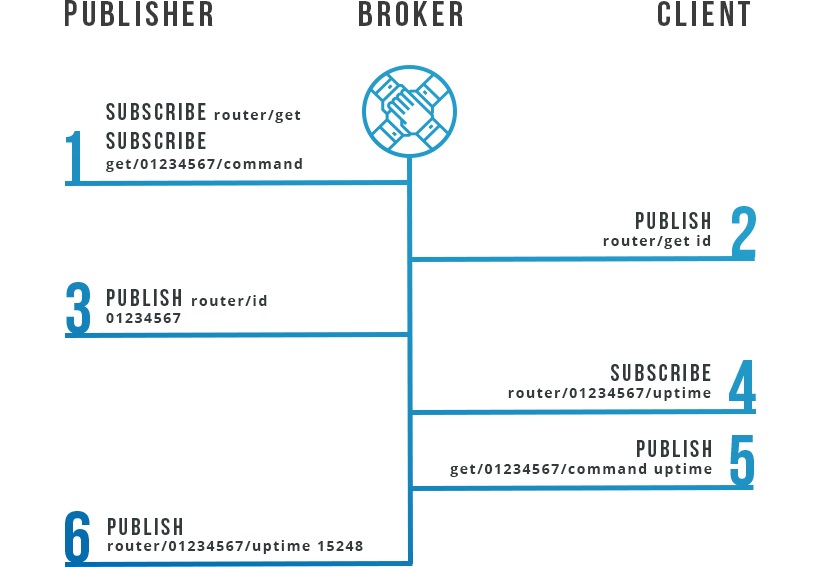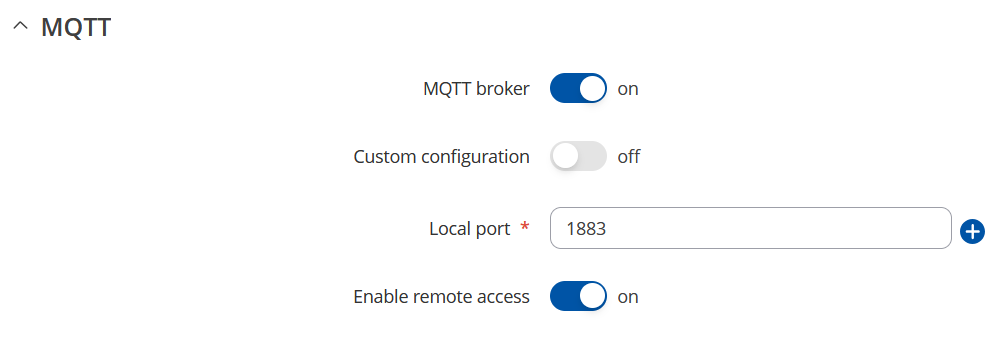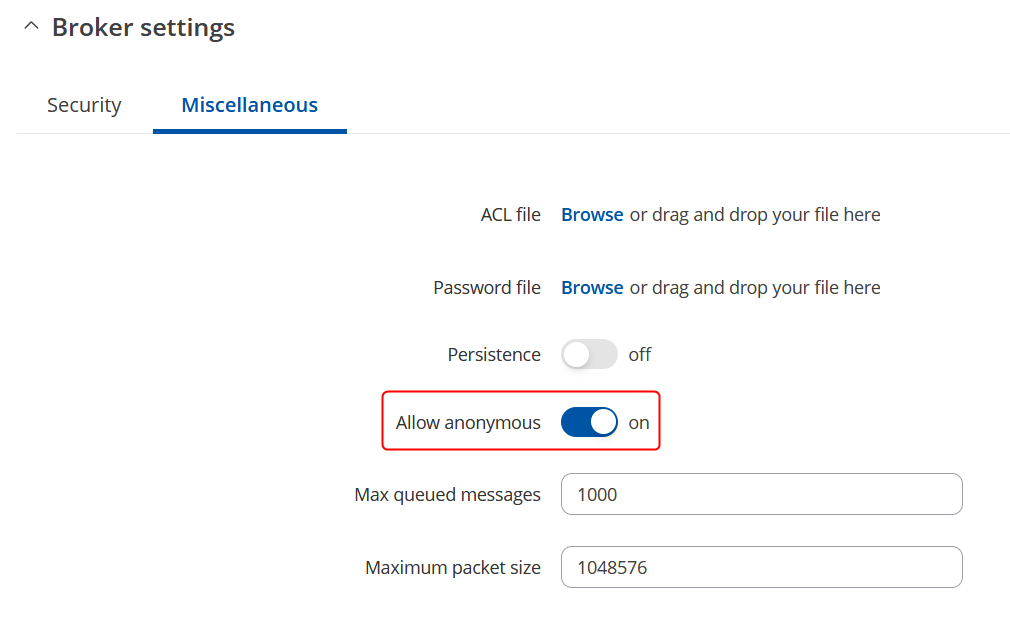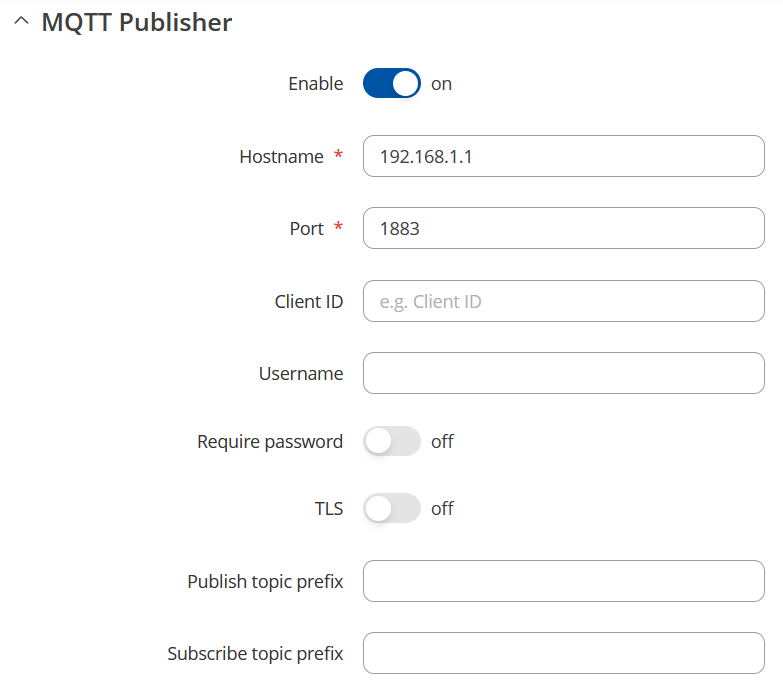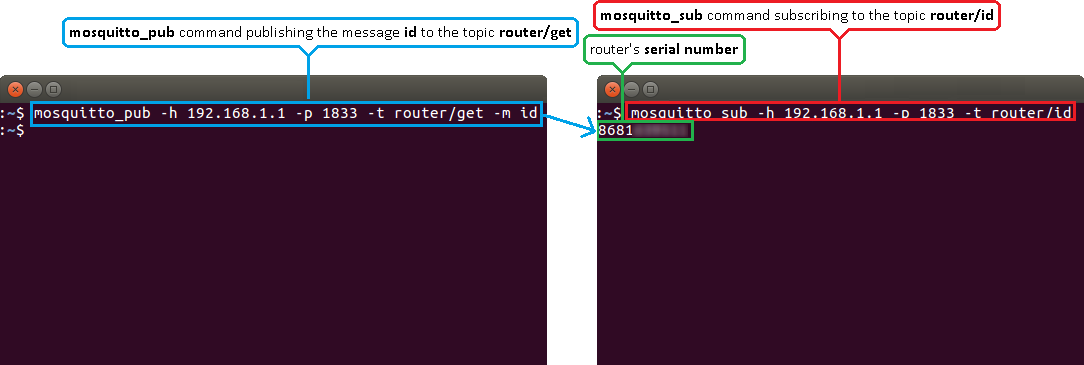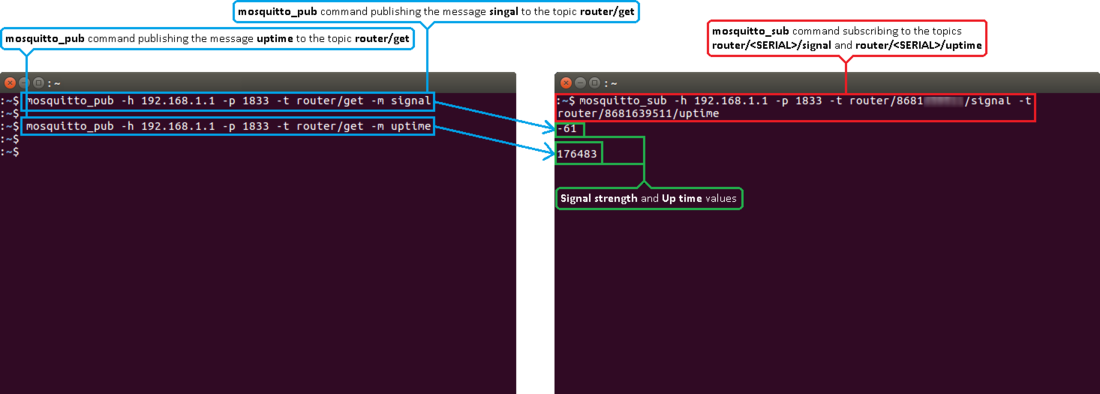Monitoring via MQTT: Difference between revisions
Gytispieze (talk | contribs) No edit summary |
No edit summary |
||
| (8 intermediate revisions by 5 users not shown) | |||
| Line 1: | Line 1: | ||
Router monitoring via MQTT Linux guide applies to TRB | Router monitoring via MQTT Linux guide applies to TRB gateways and to RUT routers. | ||
==Introduction== | ==Introduction== | ||
'''MQTT (MQ Telemetry Transport or Message Queue Telemetry Transport)''' is an ISO standard (ISO/IEC PRF 20922) publish-subscribe-based messaging protocol. It works on top of the TCP/IP protocol. It is designed for connections with remote locations where a "small code footprint" is required or the network bandwidth is limited. The publish-subscribe messaging pattern requires a message broker. | '''MQTT (MQ Telemetry Transport or Message Queue Telemetry Transport)''' is an ISO standard (ISO/IEC PRF 20922) publish-subscribe-based messaging protocol. It works on top of the TCP/IP protocol. It is designed for connections with remote locations where a "small code footprint" is required or the network bandwidth is limited. The publish-subscribe messaging pattern requires a message broker. | ||
This article provides a guide on how to configure and use a basic MQTT setup on TRB | This article provides a guide on how to configure and use a basic MQTT setup on TRB gateways and on RUT routers. | ||
==How MQTT works== | ==How MQTT works== | ||
In general an MQTT connection takes place between two Clients and a Broker. A TRB device and RUT/TCR router can be Broker, Client or both. The MQTT Publisher(Client) present in TRB devices and RUT/TCR routers subscribes to two topics by default: '''<TYPE>/get''' and '''get/<SERIAL>/command'''. Where '''<TYPE>''' is device type, for RUT/TCR routers | In general an MQTT connection takes place between two Clients and a Broker. A TRB device and RUT/TCR router can be Broker, Client or both. The MQTT Publisher(Client) present in TRB devices and RUT/TCR routers subscribes to two topics by default: '''<TYPE>/get''' and '''get/<SERIAL>/command'''. Where '''<TYPE>''' is the device type, for RUT/TCR routers type is '''router''' and for TRB devices type is '''device'''. Parameter '''<SERIAL>''' is the router's serial number. When a third-party client connects to the Broker, it sends the message '''id''' to the the topic '''<TYPE>/get'''. The publisher then sends a response containing its serial number to the topic '''<TYPE>/id'''. Now that the Client knows the router's or device's serial number it can ask for values of various parameters by sending requests to the topic '''<TYPE>/<SERIAL>/parameter_name'''. The MQTT Publisher can send responses containing values of the system parameters if the device supports that parameter: | ||
{| class="wikitable" | {| class="wikitable" | ||
| Line 15: | Line 15: | ||
! style="width: 300; background: black; color: white;" | Supported devices | ! style="width: 300; background: black; color: white;" | Supported devices | ||
|- | |||
! style="text-align: left; vertical-align: top;" | id | |||
| style="text-align: left; vertical-align: top;" | Modem IMEI | |||
| style="text-align: left; vertical-align: top;" | RUT2, RUT9, RUTX, RUT3, RUT1, TRB2, TRB5, OTD, RUT1, RUTM, RUTC | |||
|- | |- | ||
! style="text-align: left; vertical-align: top;" | temperature | ! style="text-align: left; vertical-align: top;" | temperature | ||
| style="text-align: left; vertical-align: top;" | Temperature of the module in 0.1 degrees Celsius | | style="text-align: left; vertical-align: top;" | Temperature of the module in 0.1 degrees Celsius | ||
| style="text-align: left; vertical-align: top;" | RUT2, RUT9, RUTX, RUT3, | | style="text-align: left; vertical-align: top;" | RUT2, RUT9, RUTX, RUT3, RUT1, TRB2, TRB5, OTD, RUT1, RUTM, RUTC | ||
|- | |- | ||
! style="text-align: left; vertical-align: top;" | operator | ! style="text-align: left; vertical-align: top;" | operator | ||
| style="text-align: left; vertical-align: top;" | Current operator’s name | | style="text-align: left; vertical-align: top;" | Current operator’s name | ||
| style="text-align: left; vertical-align: top;" | RUT2, RUT9, RUTX, RUT3, | | style="text-align: left; vertical-align: top;" | RUT2, RUT9, RUTX, RUT3, RUT1, TRB1, TRB2, TRB5, OTD, RUTM, RUTC | ||
|- | |- | ||
! style="text-align: left; vertical-align: top;" | signal | ! style="text-align: left; vertical-align: top;" | signal | ||
| style="text-align: left; vertical-align: top;" | Signal strength in dBm | | style="text-align: left; vertical-align: top;" | Signal strength in dBm | ||
| style="text-align: left; vertical-align: top;" | RUT2, RUT9, RUTX, RUT3, | | style="text-align: left; vertical-align: top;" | RUT2, RUT9, RUTX, RUT3, RUT1, TRB1, TRB2, TRB5, OTD, RUTM, RUTC | ||
|- | |- | ||
! style="text-align: left; vertical-align: top;" | network | ! style="text-align: left; vertical-align: top;" | network | ||
| style="text-align: left; vertical-align: top;" | Network state | | style="text-align: left; vertical-align: top;" | Network state | ||
| style="text-align: left; vertical-align: top;" | RUT2, RUT9, RUTX, RUT3, | | style="text-align: left; vertical-align: top;" | RUT2, RUT9, RUTX, RUT3, RUT1, TRB1, TRB2, TRB5, OTD, RUTM, RUTC | ||
|- | |- | ||
! style="text-align: left; vertical-align: top;" | connection | ! style="text-align: left; vertical-align: top;" | connection | ||
| style="text-align: left; vertical-align: top;" | Current connection type (2G, 3G, 4G) | | style="text-align: left; vertical-align: top;" | Current connection type (2G, 3G, 4G) | ||
| style="text-align: left; vertical-align: top;" | RUT2, RUT9, RUTX, RUT3, | | style="text-align: left; vertical-align: top;" | RUT2, RUT9, RUTX, RUT3, RUT1, TRB1, TRB2, TRB5, OTD, RUTM, RUTC | ||
|- | |- | ||
! style="text-align: left; vertical-align: top;" | wan | ! style="text-align: left; vertical-align: top;" | wan | ||
| style="text-align: left; vertical-align: top;" | WAN IP address | | style="text-align: left; vertical-align: top;" | WAN IP address | ||
| style="text-align: left; vertical-align: top;" | RUT2, RUT9, RUTX, RUT3, | | style="text-align: left; vertical-align: top;" | RUT2, RUT9, RUTX, RUT3, RUT1, TRB1, TRB2, TRB5, OTD, RUT1, RUTM, RUTC | ||
|- | |- | ||
! style="text-align: left; vertical-align: top;" | uptime | ! style="text-align: left; vertical-align: top;" | uptime | ||
| style="text-align: left; vertical-align: top;" | System uptime in seconds | | style="text-align: left; vertical-align: top;" | System uptime in seconds | ||
| style="text-align: left; vertical-align: top;" | RUT2, RUT9, RUTX, RUT3, | | style="text-align: left; vertical-align: top;" | RUT2, RUT9, RUTX, RUT3, RUT1, TRB1, TRB2, TRB5, OTD, RUT1, RUTM, RUTC | ||
|- | |- | ||
! style="text-align: left; vertical-align: top;" | name | ! style="text-align: left; vertical-align: top;" | name | ||
| style="text-align: left; vertical-align: top;" | Device's device code | | style="text-align: left; vertical-align: top;" | Device's device code | ||
| style="text-align: left; vertical-align: top;" | RUT2, RUT9, RUTX, RUT3, | | style="text-align: left; vertical-align: top;" | RUT2, RUT9, RUTX, RUT3, RUT1, TRB1, TRB2, TRB5, OTD, RUT1, RUTM, RUTC | ||
|- | |- | ||
! style="text-align: left; vertical-align: top;" | digital1 | ! style="text-align: left; vertical-align: top;" | digital1 | ||
| Line 58: | Line 62: | ||
! style="text-align: left; vertical-align: top;" | analog | ! style="text-align: left; vertical-align: top;" | analog | ||
| style="text-align: left; vertical-align: top;" | Value of analog | | style="text-align: left; vertical-align: top;" | Value of analog | ||
| style="text-align: left; vertical-align: top;" | RUT9, TRB2 | | style="text-align: left; vertical-align: top;" | RUT9, TRB2, TRB141 | ||
|- | |- | ||
! style="text-align: left; vertical-align: top;" | pin2 | ! style="text-align: left; vertical-align: top;" | pin2 | ||
| Line 66: | Line 70: | ||
! style="text-align: left; vertical-align: top;" | pin3 | ! style="text-align: left; vertical-align: top;" | pin3 | ||
| style="text-align: left; vertical-align: top;" | Value of 3's pin state | | style="text-align: left; vertical-align: top;" | Value of 3's pin state | ||
| style="text-align: left; vertical-align: top;" | RUT2, RUT9, RUTX, RUT3, TRB1, TRB2 | | style="text-align: left; vertical-align: top;" | RUT1, RUT2, RUT9, RUTX, RUT3, TRB1, TRB2, TRB5, RUTM | ||
|- | |- | ||
! style="text-align: left; vertical-align: top;" | pin4 | ! style="text-align: left; vertical-align: top;" | pin4 | ||
| style="text-align: left; vertical-align: top;" | Value of 4's pin state | | style="text-align: left; vertical-align: top;" | Value of 4's pin state | ||
| style="text-align: left; vertical-align: top;" | RUT2, RUT9, RUTX, RUT3, TRB1, TRB2 | | style="text-align: left; vertical-align: top;" | RUT1, RUT2, RUT9, RUTX, RUT3, TRB1, TRB2, TRB5, RUTM | ||
|- | |- | ||
|} | |} | ||
| Line 79: | Line 83: | ||
[[File:Configuration examples mqtt scheme v2.jpg|border|class=tlt-border]] | [[File:Configuration examples mqtt scheme v2.jpg|border|class=tlt-border]] | ||
It should also be noted that, according to the MQTT protocol, topic names are case-sensitive. For instance, topic ''router'' is not the same as topic '' | It should also be noted that, according to the MQTT protocol, topic names are '''case-sensitive'''. For instance, topic '''''router''''' is not the same as topic '''''ROUTER'''''. | ||
==Configuring the device== | ==Configuring the device== | ||
This section will provide an explanation on how to configure an MQTT Broker and MQTT Publisher on a TRB | This section will provide an explanation on how to configure an MQTT Broker and MQTT Publisher on a TRB gateways and on RUT routers. | ||
===Broker=== | ===Broker=== | ||
---- | ---- | ||
Basic (not counting Security, Bridge and Miscellaneous Broker settings) Broker configuration only contains three fields. Make sure to '''Enable''' the Broker and specify a '''Port''' for connection to the Broker. ''' Enable Remote Access''' if you wish to connect to your router remotely (via WAN). Although in this case your router would need to have a Public IP address. In image below is presented how to configure | Basic (not counting Security, Bridge and Miscellaneous Broker settings) Broker configuration only contains three fields. Make sure to '''Enable''' the Broker and specify a '''Port''' for connection to the Broker. ''' Enable Remote Access''' if you wish to connect to your router remotely (via WAN). Although in this case your router would need to have a Public IP address. In image below is presented how to configure routers: | ||
[[ | [[File:Monitoring_via_mqtt_enable.png|border|class=tlt-border|500x167]] | ||
If you want to access the broker without password or ACL file, then you need to enable "Allow anonymous" option in Broker settings -> Miscellaneous section: | |||
[[ | [[File:Monitoring_via_mqtt_broker_misc_anon.png|border|class=tlt-border|500x167]] | ||
===Publisher=== | ===Publisher=== | ||
---- | ---- | ||
Publisher configuration is similar in its simplicity to the Broker configuration. Make sure to '''Enable''' the Publisher and specify a '''Port''' for connection to a Broker. If you plan on using the router's Broker, specify the same port as the one in the Broker Settings section. '''Hostname''' is the Broker's host name or IP address. If you're using the router's Broker, specify your router's LAN IP address. '''Username''' and '''Password''' are optional and depend on the type of security (if any) that the Broker uses. In image below is presented how configure | Publisher configuration is similar in its simplicity to the Broker configuration. Make sure to '''Enable''' the Publisher and specify a '''Port''' for connection to a Broker. If you plan on using the router's Broker, specify the same port as the one in the Broker Settings section. '''Hostname''' is the Broker's host name or IP address. If you're using the router's Broker, specify your router's LAN IP address. '''Username''' and '''Password''' are optional and depend on the type of security (if any) that the Broker uses. In image below is presented how configure TRB gateways and RUT routers: | ||
[[ | [[File:Monitoring_via_mqtt_publisher_general.png|border|class=tlt-border]] | ||
<b>NOTE</b>: If you are configuring a TRB device, default hostname is 192.168.2.1. | <b>NOTE</b>: If you are configuring a TRB device, default hostname is 192.168.2.1. | ||
| Line 131: | Line 131: | ||
In image below is presented example of how to get RUT router serial number: | In image below is presented example of how to get RUT router serial number: | ||
[[ | [[File:Configuration examples mqtt router id new 1.png|border|class=tlt-border]] | ||
| Line 155: | Line 155: | ||
In example below you can see how to subscribe and publish to the topics '''signal strength''' and '''uptime''' on RUT/TCR routers: | In example below you can see how to subscribe and publish to the topics '''signal strength''' and '''uptime''' on RUT/TCR routers: | ||
[[File:Configuration examples mqtt subscribe publish | [[File:Configuration examples mqtt subscribe publish new 2.png|1100px|border|class=tlt-border]] | ||
==External links== | |||
https://mosquitto.org/ - Eclipse Mosquitto official website | |||
[[Category:Router control and monitoring]] | |||
Latest revision as of 13:15, 25 July 2024
Main Page > General Information > Configuration Examples > Router control and monitoring > Monitoring via MQTTRouter monitoring via MQTT Linux guide applies to TRB gateways and to RUT routers.
Introduction
MQTT (MQ Telemetry Transport or Message Queue Telemetry Transport) is an ISO standard (ISO/IEC PRF 20922) publish-subscribe-based messaging protocol. It works on top of the TCP/IP protocol. It is designed for connections with remote locations where a "small code footprint" is required or the network bandwidth is limited. The publish-subscribe messaging pattern requires a message broker.
This article provides a guide on how to configure and use a basic MQTT setup on TRB gateways and on RUT routers.
How MQTT works
In general an MQTT connection takes place between two Clients and a Broker. A TRB device and RUT/TCR router can be Broker, Client or both. The MQTT Publisher(Client) present in TRB devices and RUT/TCR routers subscribes to two topics by default: <TYPE>/get and get/<SERIAL>/command. Where <TYPE> is the device type, for RUT/TCR routers type is router and for TRB devices type is device. Parameter <SERIAL> is the router's serial number. When a third-party client connects to the Broker, it sends the message id to the the topic <TYPE>/get. The publisher then sends a response containing its serial number to the topic <TYPE>/id. Now that the Client knows the router's or device's serial number it can ask for values of various parameters by sending requests to the topic <TYPE>/<SERIAL>/parameter_name. The MQTT Publisher can send responses containing values of the system parameters if the device supports that parameter:
| Parameter name | Parameter description | Supported devices |
|---|---|---|
| id | Modem IMEI | RUT2, RUT9, RUTX, RUT3, RUT1, TRB2, TRB5, OTD, RUT1, RUTM, RUTC |
| temperature | Temperature of the module in 0.1 degrees Celsius | RUT2, RUT9, RUTX, RUT3, RUT1, TRB2, TRB5, OTD, RUT1, RUTM, RUTC |
| operator | Current operator’s name | RUT2, RUT9, RUTX, RUT3, RUT1, TRB1, TRB2, TRB5, OTD, RUTM, RUTC |
| signal | Signal strength in dBm | RUT2, RUT9, RUTX, RUT3, RUT1, TRB1, TRB2, TRB5, OTD, RUTM, RUTC |
| network | Network state | RUT2, RUT9, RUTX, RUT3, RUT1, TRB1, TRB2, TRB5, OTD, RUTM, RUTC |
| connection | Current connection type (2G, 3G, 4G) | RUT2, RUT9, RUTX, RUT3, RUT1, TRB1, TRB2, TRB5, OTD, RUTM, RUTC |
| wan | WAN IP address | RUT2, RUT9, RUTX, RUT3, RUT1, TRB1, TRB2, TRB5, OTD, RUT1, RUTM, RUTC |
| uptime | System uptime in seconds | RUT2, RUT9, RUTX, RUT3, RUT1, TRB1, TRB2, TRB5, OTD, RUT1, RUTM, RUTC |
| name | Device's device code | RUT2, RUT9, RUTX, RUT3, RUT1, TRB1, TRB2, TRB5, OTD, RUT1, RUTM, RUTC |
| digital1 | Value of digital input no. 1 | RUT9 |
| digital2 | Value of digital input no. 2 | RUT9 |
| analog | Value of analog | RUT9, TRB2, TRB141 |
| pin2 | Value of 2's pin state | TRB2 |
| pin3 | Value of 3's pin state | RUT1, RUT2, RUT9, RUTX, RUT3, TRB1, TRB2, TRB5, RUTM |
| pin4 | Value of 4's pin state | RUT1, RUT2, RUT9, RUTX, RUT3, TRB1, TRB2, TRB5, RUTM |
After the client sends a message containing of these parameters, the Publisher will send a response message containing the value of the requested parameter to the topic <TYPE>/<SERIAL>/parameter_name, where parameter_name is the name of the requested parameter. The scheme below shows example of how to get parameters on RUT routers.
It should also be noted that, according to the MQTT protocol, topic names are case-sensitive. For instance, topic router is not the same as topic ROUTER.
Configuring the device
This section will provide an explanation on how to configure an MQTT Broker and MQTT Publisher on a TRB gateways and on RUT routers.
Broker
Basic (not counting Security, Bridge and Miscellaneous Broker settings) Broker configuration only contains three fields. Make sure to Enable the Broker and specify a Port for connection to the Broker. Enable Remote Access if you wish to connect to your router remotely (via WAN). Although in this case your router would need to have a Public IP address. In image below is presented how to configure routers:
If you want to access the broker without password or ACL file, then you need to enable "Allow anonymous" option in Broker settings -> Miscellaneous section:
Publisher
Publisher configuration is similar in its simplicity to the Broker configuration. Make sure to Enable the Publisher and specify a Port for connection to a Broker. If you plan on using the router's Broker, specify the same port as the one in the Broker Settings section. Hostname is the Broker's host name or IP address. If you're using the router's Broker, specify your router's LAN IP address. Username and Password are optional and depend on the type of security (if any) that the Broker uses. In image below is presented how configure TRB gateways and RUT routers:
NOTE: If you are configuring a TRB device, default hostname is 192.168.2.1.
Configuring the PC
Once the Broker is up, you'll need to install Mosquitto and Mosquitto Clients on your PC. To do so, open the Linux Terminal app and enter this command:
$ sudo apt-get install mosquitto mosquitto-clients
NOTE: this software was chosen because it suits the needs of this example and is easily accessible to most users. It is not the only application compatible with RUT MQTT, so if you're using your own software for your solution, it is not mandatory to install this.
Subscribing and Publishing
Now you can use set up Brokers and Clients on your PC. In order to Publish commands and Subscribe to topics on a TRB series devices and RUT/TCR routers, you'll need to know the device's Serial Number and TYPE. For TRB series device's you'll need to use type : device and for RUT/TCR router's you'll need to use type: router. Router's serial number you can find in the Status → Device section of the router's WebUI. For TRB series devices serial number you can find in the Status → System section of the device WebUI. Or you can subscribe to the topic <TYPE>/id and publish the message id to the topic <TYPE>/get. To do so, enter these commands in separate Terminal windows:
Subscribe:
$ mosquitto_sub -h 192.168.1.1 -p 1833 -u user -P pass -t <TYPE>/id
Publish:
$ mosquitto_pub -h 192.168.1.1 -p 1833 -u user -P pass -t <TYPE>/get -m id
In image below is presented example of how to get RUT router serial number:
mosquitto_sub command is used to subscribe to a certain topic(s) and mosquitto_pub command is used to publish messages to specified topics. -m defines the message that you're publishing
-h indicates the host (the Broker's IP address) which, continuing from the example above, is 192.168.1.1. Replace this value with your router's LAN IP address or, if you're using MQTT remotely, your WAN IP address.
-p indicates the port used for connection to the Broker. Replace it with the port number that you specified in the Broker configuration.
-u and -P specify the username and password. If the Broker doesn't require authentication, these values aren't mandatory. Else replace them with the log in information of your Broker.
-t specifies the topics that you subscribe or publish to.
Now that we have the using device's serial number we can start publishing messages and receiving responses containing the device's system parameter values. Lets say we want to monitor the device's signal strength and up time values. In order to do that we'll need to subscribe to the topics router/<SERIAL>/signal and router/<SERIAL>/uptime using the mosquitto_sub command. Again, replace the values given in the commands below with the ones in your configuration:
Subscribe:
$ mosquitto_sub -h 192.168.1.1 -p 1833 -u user -P pass -t router/<SERIAL>/signal -t router/<SERIAL>/uptime
Publish:
$ mosquitto_pub -h 192.168.1.1 -p 1833 -u user -P pass -t router/get -m signal $ mosquitto_pub -h 192.168.1.1 -p 1833 -u user -P pass -t router/get -m uptime
In example below you can see how to subscribe and publish to the topics signal strength and uptime on RUT/TCR routers:
External links
https://mosquitto.org/ - Eclipse Mosquitto official website

